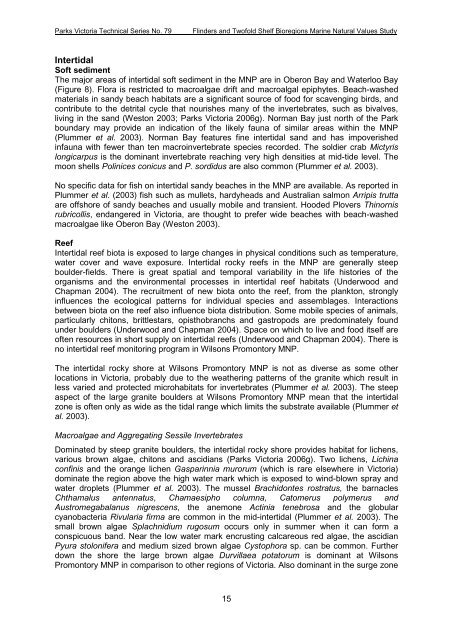parks victoria technical series marine natural values study vol 2 ...
parks victoria technical series marine natural values study vol 2 ...
parks victoria technical series marine natural values study vol 2 ...
Create successful ePaper yourself
Turn your PDF publications into a flip-book with our unique Google optimized e-Paper software.
Parks Victoria Technical Series No. 79<br />
Flinders and Twofold Shelf Bioregions Marine Natural Values Study<br />
Intertidal<br />
Soft sediment<br />
The major areas of intertidal soft sediment in the MNP are in Oberon Bay and Waterloo Bay<br />
(Figure 8). Flora is restricted to macroalgae drift and macroalgal epiphytes. Beach-washed<br />
materials in sandy beach habitats are a significant source of food for scavenging birds, and<br />
contribute to the detrital cycle that nourishes many of the invertebrates, such as bivalves,<br />
living in the sand (Weston 2003; Parks Victoria 2006g). Norman Bay just north of the Park<br />
boundary may provide an indication of the likely fauna of similar areas within the MNP<br />
(Plummer et al. 2003). Norman Bay features fine intertidal sand and has impoverished<br />
infauna with fewer than ten macroinvertebrate species recorded. The soldier crab Mictyris<br />
longicarpus is the dominant invertebrate reaching very high densities at mid-tide level. The<br />
moon shells Polinices conicus and P. sordidus are also common (Plummer et al. 2003).<br />
No specific data for fish on intertidal sandy beaches in the MNP are available. As reported in<br />
Plummer et al. (2003) fish such as mullets, hardyheads and Australian salmon Arripis trutta<br />
are offshore of sandy beaches and usually mobile and transient. Hooded Plovers Thinornis<br />
rubricollis, endangered in Victoria, are thought to prefer wide beaches with beach-washed<br />
macroalgae like Oberon Bay (Weston 2003).<br />
Reef<br />
Intertidal reef biota is exposed to large changes in physical conditions such as temperature,<br />
water cover and wave exposure. Intertidal rocky reefs in the MNP are generally steep<br />
boulder-fields. There is great spatial and temporal variability in the life histories of the<br />
organisms and the environmental processes in intertidal reef habitats (Underwood and<br />
Chapman 2004). The recruitment of new biota onto the reef, from the plankton, strongly<br />
influences the ecological patterns for individual species and assemblages. Interactions<br />
between biota on the reef also influence biota distribution. Some mobile species of animals,<br />
particularly chitons, brittlestars, opisthobranchs and gastropods are predominately found<br />
under boulders (Underwood and Chapman 2004). Space on which to live and food itself are<br />
often resources in short supply on intertidal reefs (Underwood and Chapman 2004). There is<br />
no intertidal reef monitoring program in Wilsons Promontory MNP.<br />
The intertidal rocky shore at Wilsons Promontory MNP is not as diverse as some other<br />
locations in Victoria, probably due to the weathering patterns of the granite which result in<br />
less varied and protected microhabitats for invertebrates (Plummer et al. 2003). The steep<br />
aspect of the large granite boulders at Wilsons Promontory MNP mean that the intertidal<br />
zone is often only as wide as the tidal range which limits the substrate available (Plummer et<br />
al. 2003).<br />
Macroalgae and Aggregating Sessile Invertebrates<br />
Dominated by steep granite boulders, the intertidal rocky shore provides habitat for lichens,<br />
various brown algae, chitons and ascidians (Parks Victoria 2006g). Two lichens, Lichina<br />
confinis and the orange lichen Gasparinnia murorum (which is rare elsewhere in Victoria)<br />
dominate the region above the high water mark which is exposed to wind-blown spray and<br />
water droplets (Plummer et al. 2003). The mussel Brachidontes rostratus, the barnacles<br />
Chthamalus antennatus, Chamaesipho columna, Catomerus polymerus and<br />
Austromegabalanus nigrescens, the anemone Actinia tenebrosa and the globular<br />
cyanobacteria Rivularia firma are common in the mid-intertidal (Plummer et al. 2003). The<br />
small brown algae Splachnidium rugosum occurs only in summer when it can form a<br />
conspicuous band. Near the low water mark encrusting calcareous red algae, the ascidian<br />
Pyura stolonifera and medium sized brown algae Cystophora sp. can be common. Further<br />
down the shore the large brown algae Durvillaea potatorum is dominant at Wilsons<br />
Promontory MNP in comparison to other regions of Victoria. Also dominant in the surge zone<br />
15

















